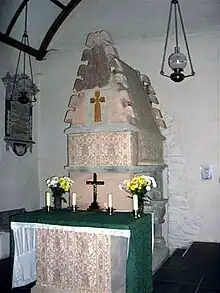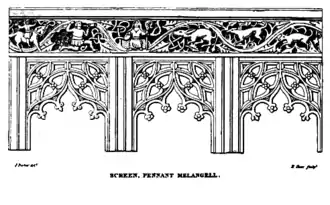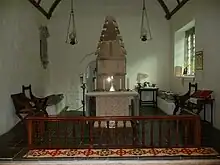Melangell
Melangell (Latin: Monacella) was an Irish nun who died in 590. Her feast day is celebrated on 27 May.[1] The daughter of an Irish king, she went to Powys in central Wales to become a hermit. The prince of Powys, Brochwel Ysgithrog, granted her land after meeting her on a hunting trip, and she founded a community of women, serving as abbess for 37 years. Her shrine remains at St Melangell's Church, Pennant Melangell.
Saint Melangell of Powys | |
|---|---|
 Shrine of St Melangell | |
| Abbess, Hermit | |
| Born | Ireland |
| Died | 590 Kingdom of Powys, Wales |
| Venerated in | Anglican Communion Catholic Church Eastern Orthodox Church Communion of Western Orthodox Churches |
| Major shrine | Saint Melangell's Church, Pennant Melangell |
| Feast | 27 May, and 5th Sunday of Pascha, the feast of the Samaritan Woman in the Orthodox Church. |
| Patronage | hares |

Legend
The Welsh antiquarian Thomas Pennant (1726–1798) related the story of Melangell.
Her legend relates that she was the daughter of an Irish monarch, who had determined to marry her to a nobleman of his court. The princess had vowed celibacy. She fled from her father's dominions and took refuge in this place, where she lived fifteen years without seeing the face of a man. Brochwel Yscythrog, Prince of Powys, being one day a hare hunting, pursued his game till he came to a great thicket; when he was amazed to find a virgin of surpassing beauty, engaged in deep devotion, with the hare he had been pursuing under her robe, boldly facing the dogs, who retired to a distance howling, notwithstanding all the efforts of the sportsmen to make them seize their prey. Even when the huntsman blew his horn, it stuck to his lips. Brochwel heard her story, and gave to God and her a parcel of lands, to be a sanctuary to all that fled there. He desired her to found an abbey on the spot. She did so, and died abbess at a good old age. She was buried in the neighbouring church, called Pennant, and from, her distinguished by the addition of Melangell. Her hard bed is shown in the cleft of a neighbouring rock. Her tomb was in a little chapel, or oratory, adjoining to the church, and now used as a vestry room. This room is still called 'Cell-y-bedd' or the Cell of the Grave. Her reliques as well as her image have been long since removed; but I think the last is still to be seen in the churchyard. The legend is perpetuated by some rude wooden carving of the Saint, with numbers of hares scuttling to her for protection. She properly became their Patroness. They were called 'Oen Melangell' (St. Monacella's Lambs).
— Thomas Pennant, [2]

Veneration
Melangell's feast day is 27th May in the Western Church, and the 5th Sunday of Pascha in the Eastern Church. She has two churches dedicated to her: her primary shrine at Pennant Melangell, and a Western Orthodox (Orthodox Church of the Gauls) church in Manchester.[3]
Shrine at St Melangell's Church

Brochwel Ysgithrog, Prince of Powys awarded the valley near Saint Melangell's Church, Pennant Melangell to Melangell as a place of sanctuary, where she became abbess of a small religious community. After her death her memory continued to be honoured at her shrine, and Pennant Melangell has been a place of pilgrimage for many centuries. Melangell remains the patron saint of hares. Bones said to be those of Melangell have been deposited within the shrine.
References
- "St. Melangell". Saints & Angels. Catholic Online.
- Pennant, Thomas (1810). Tours in Wales. Vol. 3. Wilkie and Robinson. pp. 173–174.
- "Home - Saint Melangell's Orthodox Church". www.orthodoxmanchester.org.uk. Retrieved 4 September 2023.
- St Melangell's Church & The Saint Melangell Centre
- St Melangell's Orthodox Church
- Archaeologia Cambrensis, The Journal of the Cambrian Archaeological Association, Vol. III, Sixth Series, London, 1903.
- Pennant Melangell
- Clwyd-Powys Archaeological Trust
Further reading
- Nancy Edwards, "Celtic Saints and Early Medieval Archaeology," in Local saints and local churches in the early medieval West (Oxford University Press, 2002), pp. 234ff. online.